INDIAN ARMED FORCES CHIEFS ON OUR RELENTLESS AND FOCUSED PUBLISHING EFFORTS

The insightful articles, inspiring narrations and analytical perspectives presented by the Editorial Team, establish an alluring connect with the reader. My compliments and best wishes to SP Guide Publications.

"Over the past 60 years, the growth of SP Guide Publications has mirrored the rising stature of Indian Navy. Its well-researched and informative magazines on Defence and Aerospace sector have served to shape an educated opinion of our military personnel, policy makers and the public alike. I wish SP's Publication team continued success, fair winds and following seas in all future endeavour!"

Since, its inception in 1964, SP Guide Publications has consistently demonstrated commitment to high-quality journalism in the aerospace and defence sectors, earning a well-deserved reputation as Asia's largest media house in this domain. I wish SP Guide Publications continued success in its pursuit of excellence.
- Prime Minister Modi Visits Punjab’s Adampur Air Base, Interacts with Airmen after Successful ‘Operation Sindoor’; Stern Message to Pakistan
- The layered Air Defence systems that worked superbly, the key element of Operation Sindoor
- Operation Sindoor | Day 2 DGMOs Briefing
- Operation Sindoor: Resolute yet Restrained
- India's Operation Sindoor Sends a Clear Message to Terror and the World – ‘ZERO TOLERANCE’
- Japan and India set forth a defence cooperation consultancy framework, talks on tank and jet engines
SpaceX strengthening sustainable commercial space flights
With successful launches and commercial crew missions on the list, SpaceX is advancing cost-effective space travel.
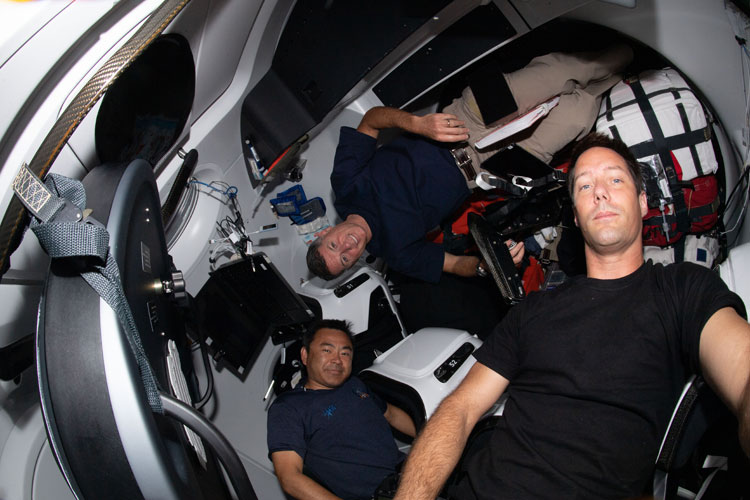
Through SpaceX as well as Tesla, Elon Musk has always stressed on putting forth sustainable energy. With the advent of SpaceX’s reusable rockets, the scope for sustainability did seem bright not just from the environment point of view but also the cost-effectiveness. Through the Commercial Crew Programme (CCP) with the National Aeronautics Space Administration (NASA), SpaceX is constantly achieving more and more feats towards this goal.
Last month four astronauts returned safely to Earth in SpaceX’s Crew Dragon, nearly six months after the crew members had arrived at the microgravity laboratory. SpaceX’s Crew Dragon, carrying NASA astronauts Michael Hopkins, Victor Glover, and Shannon Walker, and Japan Aerospace Exploration Agency (JAXA) astronaut Soichi Noguchi, returned to Earth in a parachute-assisted splashdown off the coast of Panama City, Florida on May 2, 2021 approximately 6.5 hours after undocking from the International Space Station (ISS). With the continued successes that SpaceX is adding, it is not only making way for commercial spaceflight but also increasing the chances of sustainable space travel.
Dragon driven
SpaceX’s Dragon spacecraft is the only spacecraft flying at present that is capable of returning significant amounts of cargo to Earth, and is the first private spacecraft to take humans to the space station. It is also capable of carrying up to seven passengers to and from Earth orbit, and beyond. The Dragon has had 26 total launches till now that include 24 visits to the ISS and 10 re-flown missions. The multi-purpose carrying capacity, combined with reusability, has been of significant advantage. In addition to flying astronauts to space for NASA, SpaceX’s Dragon spacecraft can also carry commercial astronauts to Earth orbit, the ISS or beyond.
The Dragon has had 26 total launches till now that include 24 visits to the ISS and 10 re-flown missions.
“We’ve accomplished another incredible spaceflight for America and our commercial and international partners. Safe, reliable transportation to the ISS is exactly the vision that NASA had when the agency embarked on the commercial crew program,” said Senator Bill Nelson, NASA Administrator after the astronauts’ return on May 2.
The four astronauts traveled 71,242,199 statute miles overall during their 168 days in orbit (with 167 days aboard the space station), and completed 2,688 orbits around Earth. With this splashdown, the crew also broke the American crewed spacecraft mission duration record of 84 days, 1 hour, 15 minutes, set by the final Skylab crew in February 1974, the space agency stated. This was also the first nighttime splashdown of a United States (U.S.) spacecraft with crew on board since Apollo 8’s return in 1968 with NASA astronauts Frank Borman, Jim Lovell and Bill Anders.
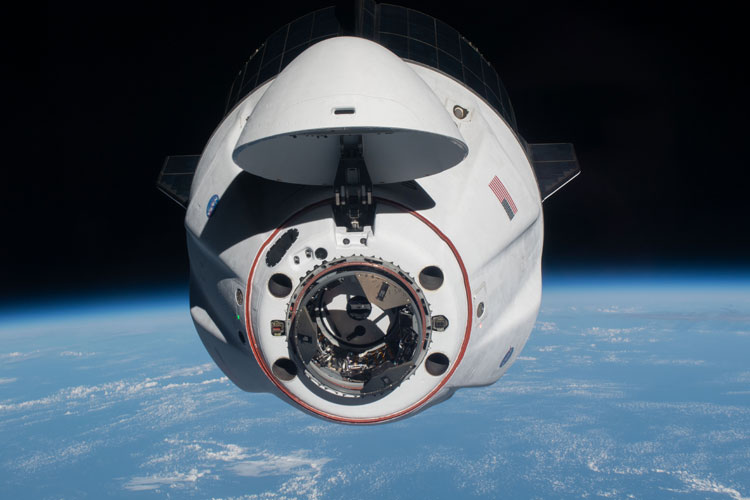
NASA’s SpaceX Crew-1 mission was launched on November 15, 2020, on a Falcon 9 rocket from the agency’s Kennedy Space Center in Florida. The astronauts named the spacecraft Resilience, and the Crew Dragon Resilience docked to the Harmony (the utility hub of the ISS) module’s forward port of the space station on November 16, nearly 27 hours after liftoff.
Commercial sustainable programs
The Crew-1 flight is part of NASA’s Commercial Crew Programme. This programme is working with the U.S. aerospace industry to launch astronauts on American rockets and spacecraft from American soil to the space station. This was the second splashdown of the Commercial Crew Programme and came about a week after the launch of NASA’s SpaceX Crew-2 mission, the second long-duration mission. In 2020, SpaceX returned America’s ability to fly NASA astronauts to and from the ISS on American vehicles for the first time since 2011.
The Crew-2 astronauts, launched on April 23, will live and work aboard the station until their return to Earth in about six months. On April 24 SpaceX’s Dragon autonomously docked with the ISS after Falcon 9 launched the spacecraft to orbit from NASA’s Kennedy Space Center.
“We’ve accomplished another incredible spaceflight for America and our commercial and international partners. Safe, reliable transportation to the ISS is exactly the vision that NASA had when the agency embarked on the commercial crew program,” said Senator Bill Nelson, NASA Administrator after the astronauts’ return on May 2.
What is special about the Crew-2 is that this is the first human spaceflight mission to fly astronauts on a flight-proven Falcon 9 and Dragon. The Falcon 9 first stage supporting this mission previously launched the Crew-1 mission in November 2020, and the Dragon spacecraft previously flew Robert Behnken and Douglas Hurley to and from the ISS during SpaceX’s Demo-2 mission in 2020.
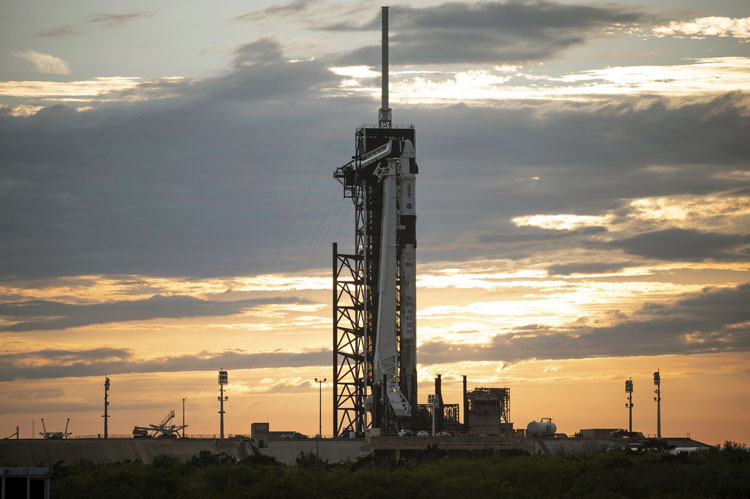
A two-stage rocket designed and manufactured by SpaceX for the reliable and safe transport of people and payloads into Earth orbit and beyond, Falcon 9 is the world’s first orbital class reusable rocket. Reusability allows SpaceX to refly the most expensive parts of the rocket, which in turn drives down the cost of space access. In addition to that it also reduces the waste that is generated due the rocket burns. Falcon 9 is designed and manufactured by SpaceX for the reliable and safe space transport into Earth orbit and beyond.
The Falcon-9 uses Merlin engines which is a family of rocket engines developed by SpaceX for use on its Falcon 1, Falcon 9 and Falcon Heavy launch vehicles. Merlin engines use a rocket grade kerosene (RP-1) and liquid oxygen as rocket propellants in a gas-generator power cycle. The Merlin engine was originally designed for recovery and reuse. This further decreases the carbon emission. The falcon has had 117 total till now, 77 total landings, and 60 re-flown rockets.
Merlin engines, designed for reuse and recovery, use a rocket grade kerosene (RP-1) and liquid oxygen as rocket propellants in a gas-generator power cycle, thus decreasing the carbon emission.
As part of the CCP, NASA astronauts Shane Kimbrough and Megan McArthur, JAXA astronaut Akihiko Hoshide, and ESA astronaut Thomas Pesquet flew aboard the Dragon spacecraft on its second operational mission to the space station. This was the first time Dragon flew two international partners and also the first time two Crew Dragons were attached simultaneously to the orbiting laboratory.
The next NASA and SpaceX crewed mission is Crew-3, which at present is targeted for an October launch while the Crew-2 astronauts are scheduled to return to Earth on October 31, about a week after welcoming their Crew-3 colleagues to the orbiting outpost.
With the goal of safe, reliable, and cost-effective transportation to and from the ISS, NASA’s Commercial Crew Program is providing additional research time and increasing the opportunity for discovery aboard humanity’s testbed for exploration, NASA remarked. Later this year, SpaceX’s 22nd Commercial Resupply Services mission is scheduled to dock at the newly vacant zenith port, bringing with it the first pair of new solar arrays.
Starlink stamina
Apart from the Crew Programme, SpaceX is also continuously launching and testing satellites with its Starship. These test flights of Starship are all about improving the understanding and development of a fully reusable transportation system designed to carry both crew and cargo on long-duration interplanetary flights, and help humanity return to the Moon, and travel to Mars and beyond, SpaceX noted.
With the goal of safe, reliable, and cost-effective transportation to and from the ISS, NASA’s Commercial Crew Programme is providing additional research time and increasing the opportunity for discovery aboard ISS.
Recently on May 15 the company launched 52 Starlink satellites, a Capella Synthetic Aperture Radar (SAR) satellite, and Tyvak-0130 from Launch Complex 39A (LC-39A) at Kennedy Space Center. “This was the eighth launch and landing of this Falcon 9 first stage booster, which previously launched NASA astronauts Bob Behnken and Doug Hurley to the ISS, ANASIS-II, CRS-21, Transporter-1, and three Starlink missions,” the company stated.
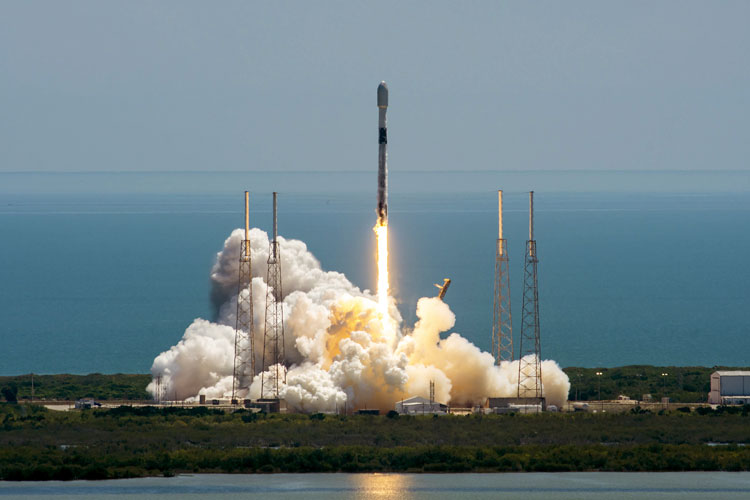
Prior to this, on May 5, Starship serial number 15 (SN15) successfully completed SpaceX’s fifth high-altitude flight test of a Starship prototype from Starbase in Texas. Similar to previous high-altitude flight tests of Starship, SN15 was powered through ascent by three Raptor engines. “SN15 performed a propellant transition to the internal header tanks, which hold landing propellant, before reorienting itself for re-entry and a controlled aerodynamic descent,” stated SpaceX.
The Starship also includes a spacious cabin and two airlocks for astronaut moonwalks. The Starship architecture is also intended to evolve to a fully reusable launch and landing system designed for travel to the Moon, Mars, and other destinations
SpaceX & NASA lunar halt
SpaceX and NASA have been associated even beyond the commercial crew programme. NASA is getting ready to send astronauts to explore more of the Moon as part of the Artemis programme and in April the agency had selected SpaceX to continue development of the first commercial human lander that will safely carry the next two American astronauts to the lunar surface.
Starship test flights are all about improving the understanding and development of a fully reusable transportation system designed to carry both crew and cargo on long-duration interplanetary flights.
The agency’s powerful Space Launch System rocket plans to launch four astronauts aboard the Orion spacecraft for their multi-day journey to lunar orbit where two crew members will transfer to the SpaceX human landing system (HLS) for the final leg of their journey to the surface of the Moon, NASA informed. SpaceX’s HLS Starship, designed to land on the Moon, leans on the company’s tested Raptor engines and flight heritage of the Falcon and Dragon vehicles.
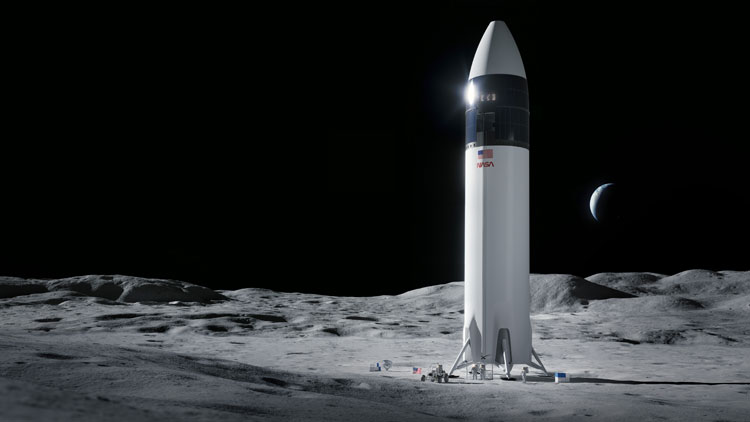
SpaceX has been closely working with NASA experts during the HLS base period of performance to inform its lander design and ensure it meets NASA’s performance requirements and human spaceflight standards. The firm-fixed price, milestone-based contract total award value was $2.89 billion.
However, about 10 days after this announcement, NASA was notified that Jeff Bezos’ Blue Origin Federation and another American company Dynetics filed protests with the US Government Accountability Office (GAO), challenging the Option A human landing system selection. NASA noted that it was notified about the protests and instructed SpaceX that progress on the HLS Option A contract has been suspended until GAO resolves all outstanding litigation related to this procurement. Further NASA implemented a no-cost extension through August 9, 2021 to each of the base period HLS contracts with Blue Origin Federation, Dynetics, and SpaceX. The three were in the competition for the contract.
Irrespective of the results that the resolution might bring, with the success of recent launches and the Commercial Crew Program missions, SpaceX has certainly added a new dimension to the spaceflight scenario not just in America but across the globe and hopefully more such reusable and environment friendly designs will come forth as the space activities increase.





